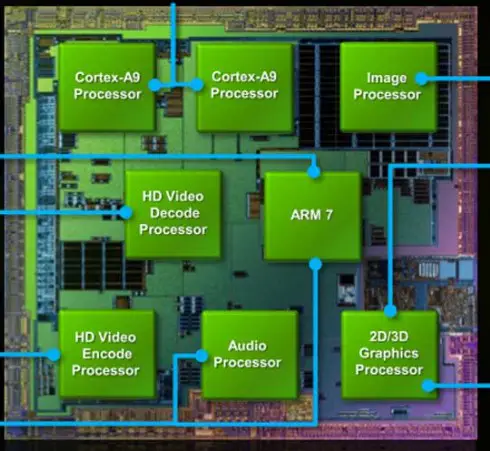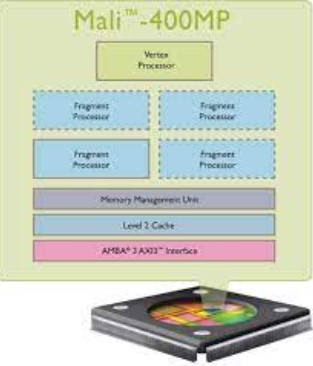Mobile technology, especially in the realm of graphics processing units (GPUs), has advanced significantly over the last decade. This evolution has played a pivotal role in shaping the capabilities of mobile devices, from enhancing user interface experiences to powering complex 3D games. Among the notable developments in this area are the Mali-400 MP GPU and the Tegra 2, both of which have set benchmarks in mobile graphics processing.
The Mali-400 MP GPU and Tegra 2 represent two distinct approaches to mobile graphics processing, each with its unique strengths. The Mali-400 MP, known for its efficient handling of 2D and 3D graphics, is optimized for power efficiency, making it a popular choice in a wide range of devices. In contrast, Tegra 2, with its integrated dual-core CPU and GPU architecture, focuses on delivering a comprehensive performance boost, particularly in multitasking and HD video playback.
Understanding the differences between these GPUs provides insights into their design philosophies, performance capabilities, and their impact on mobile computing. The Mali-400 MP excels in extending battery life while maintaining solid graphics performance, whereas Tegra 2 aims at delivering higher computing power and better multitasking capabilities, setting the stage for future mobile computing innovations.

GPU Basics
What is a GPU?
The Graphics Processing Unit (GPU) has become an essential component in modern computing, especially in mobile devices. Unlike the Central Processing Unit (CPU) that manages a wide array of computing tasks, the GPU excels in handling visual data and image processing tasks with incredible efficiency. This specialization allows GPUs to render graphics and videos at high speeds, providing smooth and visually rich experiences for users.
The role of GPUs extends beyond just improving visuals; they also contribute significantly to the performance of various applications. By offloading graphic processing tasks from the CPU, GPUs enable smoother multitasking and application operation, making them indispensable in devices ranging from smartphones to high-end gaming consoles.
Importance in Mobile Devices
The advent of GPUs in mobile devices has revolutionized the way we experience gaming and multimedia on the go. Mobile GPUs enhance graphical performance, allowing for advanced game graphics, high-definition video playback, and swift, responsive user interfaces. Their importance is most evident in:
- Gaming: Mobile games with complex graphics and animations run smoothly thanks to the dedicated processing power of GPUs.
- User Experience: From scrolling through web pages to transitioning between apps, GPUs ensure a fluid and responsive experience.
- Energy Efficiency: By handling graphics-intensive tasks, GPUs help in reducing the load on CPUs, thereby extending battery life.
Mali-400 MP GPU
Overview
The Mali-400 MP is a multi-core GPU designed by ARM Holdings, released in 2008. It marked a significant step forward in mobile graphics technology, offering scalable and energy-efficient processing for a wide range of devices. Its flexibility in core configuration allowed manufacturers to adapt it for various performance and power consumption needs.
Architecture
The Mali-400 MP’s architecture is designed to balance high performance with low power consumption, making it suitable for mobile devices. Its architecture supports up to four cores, allowing it to handle multiple graphics processes simultaneously for enhanced rendering speed and efficiency. This GPU is designed with a focus on 2D and 3D graphics processing, boasting features that enhance image quality and support a wide range of graphical APIs.
Performance
In terms of performance, the Mali-400 MP shines with its ability to render high-quality graphics smoothly. It supports:
- High Frame Rates: Ensuring fluid motion in video playback and gaming.
- High Resolutions: Capable of driving displays with HD resolutions, providing sharp and clear visuals.
- Efficient Rendering: Its architecture optimizes the use of resources to maintain performance without draining the battery.
Power Efficiency
The Mali-400 MP’s design prioritizes power efficiency, making it ideal for mobile devices where battery life is crucial. It achieves this through features like smart scaling of resources and power-saving modes that reduce energy consumption when full graphical power is unnecessary.
Tegra 2
Overview
Introduced by NVIDIA in 2010, the Tegra 2 was the first dual-core SoC (System on Chip) for mobile devices, setting a new standard for mobile computing power. It combines a dual-core ARM Cortex-A9 CPU with a powerful GPU, designed to deliver high performance for gaming, multimedia playback, and multitasking.
Architecture
Tegra 2’s architecture is noteworthy for its integration of a multicore CPU with a GPU, which was a pioneering approach at the time. This design allows for:
- Enhanced Graphics Processing: The GPU component is specifically tailored to boost graphical output, enabling more sophisticated visual effects and smoother gameplay.
- Efficient Multitasking: The dual-core CPU arrangement facilitates better performance across multiple applications, enhancing the overall user experience.
Performance
The performance of Tegra 2 is characterized by:
- Improved Graphical Output: It supports console-quality gaming on mobile devices, with detailed textures and complex shading.
- Higher Frame Rates: Ensures smoother video playback and gaming experiences.
- Resolution Support: Capable of handling high-resolution displays, it contributes to sharper and more detailed visuals.
Power Efficiency
NVIDIA designed the Tegra 2 with an emphasis on balancing performance with energy efficiency. Its innovative architecture ensures that it can deliver high computing and graphics performance without compromising the device’s battery life, a crucial aspect for mobile users.
Frequently Asked Questions
What is a GPU?
A GPU, or Graphics Processing Unit, is a specialized processor designed to accelerate graphics rendering. In mobile devices, GPUs play a crucial role in delivering smooth visuals, enabling everything from basic user interfaces to advanced gaming experiences. By handling complex graphical tasks, GPUs improve overall device performance and efficiency.
How does Mali-400 MP differ from Tegra 2 in terms of architecture?
The Mali-400 MP GPU features a scalable, multicore design that allows for efficient handling of both 2D and 3D graphics, focusing on maximizing power efficiency. Tegra 2, on the other hand, integrates a dual-core ARM Cortex-A9 CPU with its GPU, emphasizing a balance between graphical performance and multitasking capabilities, making it suitable for more processor-intensive applications.
Which GPU is more energy-efficient, Mali-400 MP or Tegra 2?
The Mali-400 MP GPU is generally considered more energy-efficient due to its design focused on optimizing power consumption. It is particularly effective in mobile devices where battery life is a crucial concern. Tegra 2, while offering higher performance, typically consumes more power, making it less efficient in scenarios where battery preservation is paramount.
Can Mali-400 MP and Tegra 2 support the latest mobile games?
Mali-400 MP and Tegra 2 were designed to support a wide range of mobile games available at their time of release. However, due to the rapid advancements in mobile gaming technology, newer, more graphically demanding games may not perform optimally on these older GPUs. Compatibility and performance will vary based on the specific requirements of each game.
Conclusion
The comparison between Mali-400 MP and Tegra 2 underscores the diversity in design philosophies and priorities that have guided mobile GPU development. While Mali-400 MP focuses on efficiency and prolonging battery life, offering a balanced performance for everyday use, Tegra 2 aims at providing a more robust computing experience, prioritizing processing power and multitasking capabilities.
This understanding not only illuminates the technological milestones of the past but also sheds light on the evolving landscape of mobile computing. As GPUs continue to advance, the balance between power, performance, and efficiency remains a central theme, influencing the future of mobile technology and its capabilities.

